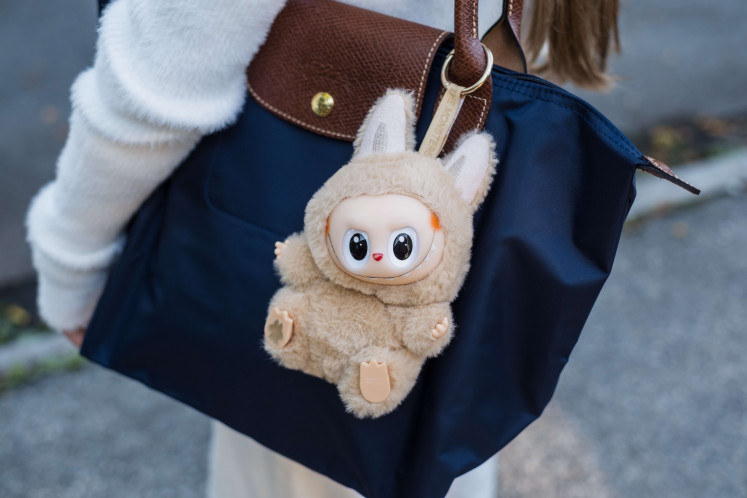Popular Reads
Top Results
Can't find what you're looking for?
View all search resultsPopular Reads
Top Results
Can't find what you're looking for?
View all search resultsTari Aceh: A dance that breathes the spirit of Islam
âTari Acehâ: The photos above and to the left show a dance troupe from Northern Sumatra during the troupeâs performance at Crowell Concert Hall, in Connecticut on Feb 27
Change text size
Gift Premium Articles
to Anyone
'Tari Aceh': The photos above and to the left show a dance troupe from Northern Sumatra during the troupe's performance at Crowell Concert Hall, in Connecticut on Feb 27.
Rateb Meuseukat is a breathtaking form of Acehnese dance that is rooted in the sacred practices of Sumatran men, but has evolved into a virtuosic expression of female solidarity. The Australian ethnomusicologist Margaret Kartomi describes it as 'art that breathes the spirit of Islam'.
Acehnese dancer Novirela Minang Sari agrees. 'We sing some of the same words during our dances that we use in prayer,' she said in an interview at the Asia Society in New York where she and eight other women from Aceh performed Rateb Meuseukat and other dances for a sold out audience.
The day after the performance some of the spectators returned to take a workshop in which they learned how to do the movements they had seen on stage.
The show and the workshop were also presented at Wesleyan University, Holy Cross College and Wellesley College, giving Americans an eye-opening introduction to an aspect of the Muslim world that is rarely seen in the West.
Images of Muslim women in Western media often focus on the restrictive nature of head scarves and other customary clothing, but the dancers of Aceh shattered these naïve stereotypes through the liberating power of their performances.
The women's colorful woven headscarves accentuated the sassy energy of their movements. Their modest costumes used traditional textiles to heighten the dynamic quality of their choreography.
The hooting, stomping, finger snapping and body slapping that punctuated their dances gave the performance an unstoppable sense of momentum that erased all notions of female passivity.
The women dancers of the 'Tari Aceh' tour were clearly the masters of the remarkable universe they created onstage.

'The boundaries of our customs may be seen by outsiders as restrictions,' says Cut Febriyanti, one of the dancers, 'but for us it is a comforting framework that inspires us to greater creativity.'
This sense of communal collectivity is expressed with great precision in the interlocking rhythms and intertwining gestures of the performance, while a sense of shared community is a cultural value deeply embedded in the life of Acehnese women. Its presence in the fabric of the dance is one of the reasons the dancers feel that their performance breathes with the spirit of Islam.
According to tour manager Ari Palawi, 'Islam has been at the heart of our culture for centuries.' He sees the dances of Aceh as an expression of pride in the Islamic heritage that goes back to the Sumatran kingdoms of the seventeenth century.
Aceh was the first kingdom to embrace the Muslim faith in what is now the Indonesian archipelago, home to more Muslims than any other country in the world.
Some scholars believe that the arts of dance, music, and shadow puppetry were used by Islamic saints to spread their faith, and this connection between art and spirituality animates all the dances in the Tari Aceh program, even those that are purely secular.
Ethnomusicologist Sumarsam of Wesleyan University says that, 'dance in Aceh is one of the best examples in positioning the performing arts as one of the major venues for the transcultural blending of Islam and local beliefs and practices ' an ongoing process throughout history.'
The blessing Asalamu'alaikum, which means 'peace be with you' is sung as part of the text of almost all the dances. Western audiences have become accustomed to hearing the phrase as a greeting in movies and television shows about terrorists.
The Acehnese dancers transform the words into a song embodied by the dancers in a multitude of gestures and physical actions that express the true meaning of the phrase.
In their performances and teaching workshops in New York, Connecticut and Massachusetts the dancers of Aceh have shown American audiences and students an expression of Islamic culture that defies common preconceptions.
As Rachel Cooper of the Asia Society said when introducing the troupe's New York debut, 'There is no time in history when we need to bridge the gap between our cultures more urgently than now.'
' Photos courtesy of Wesleyan University's Center for the Arts/Sandy Aldieri of Perception Photography











